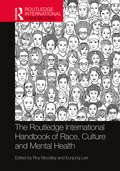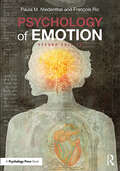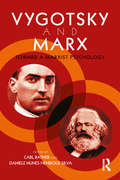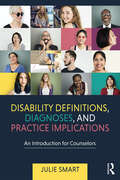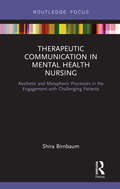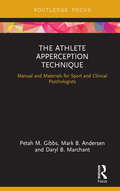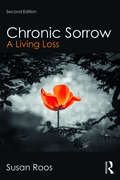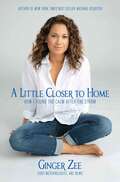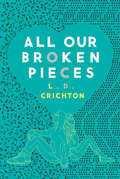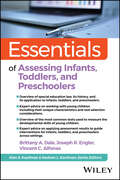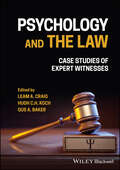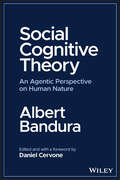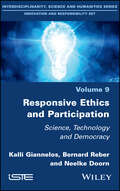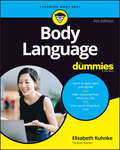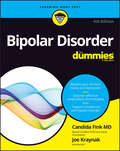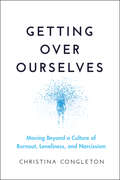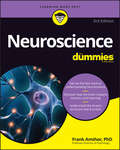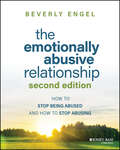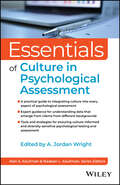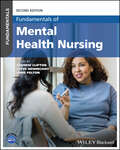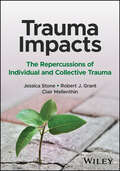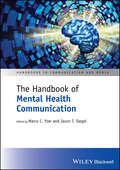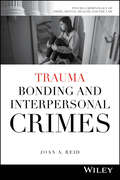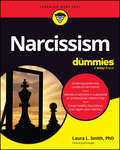- Table View
- List View
The Routledge International Handbook of Race, Culture and Mental Health (Routledge International Handbooks)
by Moodley, Roy / Lee, EunjungThis handbook presents a thorough examination of the intricate interplay of race, ethnicity, and culture in mental health – historical origins, subsequent transformations, and the discourses generated from past and present mental health and wellness practices. The text demonstrates how socio-cultural identities including race, gender, class, sexual orientation, disability, religion, and age intersect with clinical work in a range of settings. Case vignettes and recommendations for best practice help ground each in a clinical focus, guiding practitioners and educators to actively increase their understanding of non-Western and indigenous healing techniques, as well as their awareness of contemporary mental health theories as a product of Western culture with a particular historical and cultural perspective. The international contributors also discuss ways in which global mental health practices transcend racial, cultural, ethnic, linguistic, and political boundaries. The Routledge International Handbook of Race, Culture and Mental Health is an essential resource for students, researchers, and professionals alike as it addresses the complexity of mental health issues from a critical, global perspective.
Psychology of Emotion: 2nd Edition
by Paula M. Niedenthal François RicSince the turn of the twenty-first century, the psychology of emotion has grown to become its own field of study. Because the study of emotion draws inspiration from areas of science outside of psychology, including neuroscience, psychiatry, biology, genetics, computer science, zoology, and behavioral economics, the field is now often called emotion science or affective science. A subfield of affective science is affective neuroscience, the study of the emotional brain. This revised second edition of Psychology of Emotion reviews both theory and methods in emotion science, discussing findings about the brain; the function, expression, and regulation of emotion; similarities and differences due to gender and culture; the relationship between emotion and cognition; and emotion processes in groups. Comprehensive in its scope yet eminently readable, Psychology of Emotion serves as an ideal introduction for undergraduate students to the scientific study of emotion. It features effective learning devices such as bolded key terms, developmental details boxes, learning links, tables, graphs, and illustrations. In addition, a robust companion website offers instructor resources.
Vygotsky and Marx: Toward a Marxist Psychology
by Carl Ratner and Daniele Nunes Henrique SilvaThis important book fills two interrelated gaps in the field of psychology, first by developing a Marxist orientation to psychology and second by explaining how psychological pioneer Lev Vygotsky contributed greatly to this trend. Through outlining core principles in Marxist psychology, the book offers a framework for continuing Vygotsky’s Marxist legacy in new areas of the field. This book first documents the neglect in Vygotskyian studies of his deep use of Marxist concepts, and then subsequent chapters overcome this neglect. They explain the use of many Marxist concepts in his theoretical and methodological writings, demonstrating how Vygotsky utilized specific Marxist meanings in his work on consciousness, signs, development, imagination, creativity, secondary language acquisition, and unit of analysis. Chapters also address how Vygotsky dealt with incompatible theories and methodologies, illustrating how Marxist and Vygotskyian psychology can grow from anti-Marxist, anti-Vygotskyian approaches to psychology, such as psychoanalysis.This book marks an original contribution to the field of psychology, offering a new understanding of both Vygotsky’s work and cultural and Marxist psychology. Furthermore, it expands the field of Marxism to include psychology. It will be of interest to all students and researchers of cultural, educational, and developmental psychology as well as the history of psychology. It will also appeal to social theorists and Marxist scholars.
Disability Definitions, Diagnoses, and Practice Implications: An Introduction for Counselors
by Julie Smart<p>This introductory text defines and describes disability, while providing concrete practice guidelines and recommendations for students in the fields of counseling, social work, and the helping professions. Various specialty areas are explored in detail, including marriage and family counseling, adolescent counseling, addictions counseling, LGBTQ concerns, multicultural counseling, and career counseling. <p>The first three chapters lay the foundations by discussing the demand for counseling services by individuals with all types of disabilities; presenting clinical, legal, medical/biological, and personal definitions of disability; and describing physical, cognitive, and psychiatric disabilities. Next, author Julie Smart examines core beliefs about disability using a range of first-person accounts from experienced counselors. The last six chapters focus on practice guidelines for various aspects of disability—including ethical considerations, societal issues, social role demands, and individual responses—and consider new possibilities for disability counseling professions. <p>With rich case studies woven throughout, as well as valuable information on client needs, disability categorizations, and key Models of Disability, this essential textbook will be useful not only to counseling students but also to professional counselors, social workers, and psychologists.</p>
Therapeutic Communication in Mental Health Nursing: Aesthetic and Metaphoric Processes in the Engagement with Challenging Patients
by Shira BirnbaumThis book introduces an innovative technique for therapeutic communication in mental health nursing, expanding the toolkit for nurses seeking to engage challenging patients who have not responded to more conventional therapeutic methods. Linking nursing communication to current research on metaphor and figuration, it is illustrated with accessible clinical examples. Metaphor is a key component of talk-based psychotherapies. But many of the patients whom nurses encounter in the inpatient setting are not good candidates for talk-based approaches, at least initially, because they are violent, withdrawn, highly regressed, or otherwise lacking a vocabulary to convey thoughts and feelings. This book offers specific clinical examples of an approach called the "gestural bridge." This is a method for structuring games and physical activities which connect metaphorically to a patient’s personal themes, activating narrative and observational agency and enabling an exchange of meaning to begin at a time when conventional language is not available. Rooted in what nursing theorists have called the "embodied" or "aesthetic" way of knowing, this approach is both specific and easily grasped. Drawing from contemporary work in literary theory, semiotics, metaphor theory, cognitive science, philosophy, linguistics, psychoanalysis, and the arts, Therapeutic Communication in Mental Health Nursing is important reading for advanced-level practitioners, students, and researchers interested in communication and relationship-building in nursing.
The Athlete Apperception Technique: Manual and Materials for Sport and Clinical Psychologists (Routledge Research in Sport and Exercise Science)
by Daryl B. Marchant Mark B. Andersen Petah M. GibbsAs the field of sport psychology has matured, so a greater appreciation for a diversity of training models, research methodologies, and therapeutic approaches, opposed to the dominant models of objective testing, has developed. The Athlete Apperception Technique (AAT) sets out a sport-specific projective test for practitioners working in sport and exercise service delivery or counselling work with athletes and coaches. This innovative book includes a basic primer on projective methods and the psychoanalytic theory behind them; a history of projective, storytelling instruments in clinical psychology; the development of the image set for the AAT; some examples of interpreting AAT image stories; instructions for the administration of the AAT; a scoring guide for the stories produced; and in-depth descriptions of the stimulus properties of each image in the AAT, along with all images presented as full-page illustrations. The AAT will help sport practitioners identify and assess personality features, relationships, anxieties, achievement, motivation, and perfectionism, and augment the recent shift in orientation for service delivery to athletes and provide a more in-depth understanding of athletes’ characters. The AAT is useful supplementary reading for students of sport psychology and a novel tool for any practicing sport psychologist.
Chronic Sorrow: A Living Loss (Series in Death, Dying, and Bereavement)
by Susan RoosChronic Sorrow explores natural grief reactions to losses that are not final and continue to be present in the life of the griever. This second edition updates terminology, pertinent research, and the roles the concept of chronic sorrow has come to play in the nursing, medical, social work, pastoral, and community counseling professions, among others. This text also extends the concept’s usefulness to other ongoing losses that are bases for non-ending grief responses, such as serious disabilities. Benefits and social supports are explored in depth, giving readers a practical guide for accessing available resources. Chapters also give guidance for professionals to assist individuals and families who struggle with living with irremovable loss, helping them plan for a future in which customary caregivers can no longer carry the load.
A Little Closer to Home: How I Found the Calm After the Storm
by Ginger ZeeIn Ginger Zee's follow-up to the bestselling Natural Disaster, the ABC chief meteorologist takes readers on a much deeper journey of self discovery. <p><p> When Ginger Zee opened her life to readers in Natural Disaster, the response was enormous. She put a very relatable if surprising face on depression and has helped lessen the stigma surrounding mental health issues. But Ginger tells us, Natural Disaster was "Ginger Lite" and only scratched the surface. <p><p> In this moving follow-up, Ginger shares her truest self. She spent most of her life shielding her vulnerabilities from the world all while being a professional people pleaser. Her stormy childhood, her ongoing struggles with crippling depression, her suicide attempts, and many other life experiences will resonate with readers who are likely to see themselves along the way. <p><p> In spite of its serious subject matter, Ginger's positive, life-affirming outlook comes through loud and clear. Written with great heart and quite a bit of humor, Ginger normalizes issues and challenges millions of people face every day. <p><p>A Little Closer to Home will broaden the conversation around mental health at a time we need it more than ever. <p> <b>New York Times Bestseller</b>
All Our Broken Pieces
by L.D. CrichtonYou can't keep two people who are meant to be together apart for long...Lennon Davis doesn't believe in much, but she does believe in the security of the number five. If she flicks the bedroom light switch five times, maybe her new LA school won't suck. But that doesn't feel right, so she flicks the switch again. And again. Ten more flicks of the switch and maybe her new stepfamily will accept her. Twenty-five more flicks and maybe she won't cause any more of her loved ones to die. Fifty more and then she can finally go to sleep. Kyler Benton witnesses this pattern of lights from the safety of his tree house in the yard next door. It is only there, hidden from the unwanted stares of his peers, that Kyler can fill his notebooks with lyrics that reveal the true scars of the boy behind the oversize hoodies and caustic humor. But Kyler finds that descriptions of blond hair, sad eyes, and tapping fingers are beginning to fill the pages of his notebooks. Lennon, the lonely girl next door his father has warned him about, infiltrates his mind. Even though he has enough to deal with without Lennon's rumored tragic past in his life, Kyler can't help but want to know the truth about his new muse.
Essentials of Assessing Infants, Toddlers, and Preschoolers (Essentials of Psychological Assessment)
by Vincent C. Alfonso Joseph R. Engler Brittany A. DaleA practitioner-oriented guide to the most important assessments and evaluation techniques for children ages 0-5 Many assessment professionals leave their graduate education programs without any formal training in assessing infants and young children. Although there are assessment textbooks covering subsets of this age range, Essentials of Assessing Infants, Toddlers, and Pre-Schoolers is uniquely designed for busy practitioners, and it covers the full range of assessments for 0-5 years old. With medical advances and new treatments, there is a higher prevalence of children with complex medical and psychological needs. Additionally, changing educational policies often affect assessment practices. Assessment professionals must have current information to effectively assess young children and assist in planning interventions. As with all volumes in the Essentials of Psychological Assessment series, this book consists of concise chapters featuring callout boxes highlighting key concepts, easy-to-learn bullet points, and extensive illustrative material, as well as test questions that help you gauge and reinforce your grasp of the information covered. Understand the issues unique to assessing children aged 0-5 years Get expert advice on assessing children with extremely early preterm birth, genetic conditions, and other unique situations Consider the future directions in the assessment of infants, toddlers, and preschoolers Quickly and easily locate pertinent information and access resources and tools to aid in performing professional duties This straightforward manual includes thorough coverage on how assessment results guide effective interventions. Essentials of Assessing Infants, Toddlers, and Pre-Schoolers is a valuable addition to the libraries of developmental practitioners, school and clinical psychologists, pediatricians, speech-language pathologists, and others responsible for the assessment of very young children.
Psychology and the Law: Case Studies of Expert Witnesses
by Leam A. Craig Gus A. Baker Hugh C. H. KochPSYCHOLOGY AND THE LAW Discover first-hand insights into the experience of acting as a psychologist expert witness In Psychology and the Law: Case Studies of Expert Witnesses, a team of distinguished psychologists delivers an insightful and practical collection of case studies exploring the role of mental health professionals acting as expert witnesses in regulatory, judicial, and quasi-judicial proceedings. Each chapter is authored by an expert in their field, covering situations ranging from the assessment of people involved in criminal and family law proceedings and Parole Board hearings to the assessment of a civil litigant’s experience of historical trauma resulting from the alleged negligence of the local authority. Each case follows the involvement of the practitioner from initial retainer to the process of giving evidence in court or in a court-like proceeding. The book also offers valuable judicial and legal perspectives on the roles played by mental health professionals acting as expert witnesses, as well as discussion of the cross examination of persons giving psychological evidence. Readers will also find: A thorough introduction to the use of psychologists as expert witnesses Comprehensive explorations of clinical forensic expert witness case studies Practical discussions of medicolegal expert witness case studies Fulsome treatments of judicial and legal perspectives on the roles, uses, and limits of psychological evidence and the use of psychologist experts in military court martials Perfect for undergraduate and postgraduate students of law and psychology, Psychology and the Law: Case Studies of Expert Witnesses will also benefit qualified psychologists, psychiatrists, lawyers, policymakers and legislators, social workers, and members of the judiciary.
Social Cognitive Theory: An Agentic Perspective on Human Nature
by Albert BanduraA comprehensive perspective on human nature by one of the undisputed masters of the psychological sciences The final book by psychology's most eminent modern figure, Dr. Albert Bandura, is the definitive concise presentation of his theoretical views. In Social Cognitive Theory: An Agentic Perspective on Human Nature, Bandura explains how his half-century of research and theory on the determinants of thought and action highlight people's capacity for agency: the ability to exert control over one's actions and the courses of one's development. He further explains how his basic theory and research have been applied, world-wide, for the betterment of the human condition. Readers will find: A thorough introduction to the author’s agentic-perspective on human nature Dr. Bandura's theoretical analyses of moral behavior and moral disengagement Applications of the basic principles of Social Cognitive Theory to personal and social change for human betterment An essential and groundbreaking resource for educational, health, and personality psychologists, Social Cognitive Theory: An Agentic Perspective on Human Nature will also prove indispensable to social and industrial/organizational psychologists.
Responsive Ethics and Participation: Science, Technology and Democracy
by Bernard Reber Neelke Doorn Kalli GiannelosTaking stock of the overall confused picture that research and innovation (R&I) literature and practices offer with regard to citizen and stakeholder participation, this book provides a methodical conceptual and an empirical analysis to determine the connection between ethics and participation. Strong theoretical pillars in the fields of ethics, politics and responsible research and innovation (RRI) form the backbone of this critical approach to participation, which considers new approaches to democratic participation. Taking into account a number of participatory processes, Responsive Ethics and Participation establishes a new methodology to differentiate, classify and understand the added value of the participation of citizens and stakeholders in R&I.Participation could be considered the epitome of innovation ethics. However, its multidimensionality, its ethical and theoretical grounds and the nature of the involvement and related outcomes must be clarified at the outset, in order to reach active forms of participation. Ethical participation is required for reliable developments in science and technology, which is what this book ultimately demonstrates.
Body Language For Dummies
by Elizabeth KuhnkeAre your words and your body telling the same story? Discover the impact that nonverbal behavior has on communication Much of a message’s meaning comes through what’s not being said. To master the art of clear communication, you need to be able to read others’ body language and remain mindful of the messages your own gestures, movements, and facial expressions are sending. Body Language For Dummies shows you how to interpret nonverbal cues at work and in your personal life. With the help of this easy-to-follow Dummies guide, you can navigate the gap between words and meaning—even in multicultural settings. Plus, this updated edition goes virtual, with new insights demonstrating the significance of facial expressions and body language in online vs. in-person meetings. Gain insight into other people’s thoughts, feelings, and intentions Develop an awareness of how your body language influences others’ opinions Make the camera your friend during virtual meetings Learn tips and tricks to uncover people’s real attitudes and motivationsIf you want to better understand others and improve your own communication skills (and who doesn’t?), this is the Dummies book for you.
Bipolar Disorder For Dummies
by Candida Fink Joseph KraynakWrap your mind around bipolar disorder and understand your treatment options Bipolar Disorder For Dummies, Second Edition explains everything about this common mental health diagnosis in easy-to-understand terms. If you or a loved one has recently been diagnosed with bipolar disorder, you aren’t alone. This book helps make sense of options when it comes to medications, therapies, and treatments that could improve your quality of life. You can live a full life with bipolar disorder by managing your symptoms and following a solid treatment plan. With compassionate advice and friendly insights, this book empowers you with the information you need to find support for yourself or assist a loved one who has been diagnosed with bipolar disorder. This updated edition covers emerging and alternative therapies, including ketamine, transcranial magnetic stimulation (TMS), marijuana, and psychedelics. Get the latest on medical, therapeutic, and self-help strategies for bipolar management Navigate your way through the challenges of a bipolar diagnosis Learn the chemistry behind bipolar disorder—in terms anyone can understand Control symptoms, function in times of crisis, and plan ahead for manic or depressive episodesIf you suspect you may have bipolar disorder, if you have recently been diagnosed, or if you have a loved one with bipolar disorder, this Dummies guide offers you an accessible resource for learning all the basics.
Getting Over Ourselves: Moving Beyond a Culture of Burnout, Loneliness, and Narcissism
by Christina CongletonMove beyond empty “life hacks” to connect with your deepest humanity In Getting Over Ourselves: Moving Beyond a Culture of Burnout, Loneliness, and Narcissism, human development specialist and leadership coach Christina Congleton delivers an insightful and urgently needed discussion of how people can break out of the tired cliches of the self-help genre, and move toward new levels of connection, engagement, and capacity in navigating an uncertain world. In the book, you'll explore how modern attitudes of individualism that were once freeing now converge with environmental destruction, inequality, and an alarming uptick in depression, substance abuse, and suicide to significantly damage the potential of people everywhere. You'll also find concrete strategies—rooted in developmental psychology—that show us new ways to approach these challenging times. Getting Over Ourselves offers: Insights into why “life hacks,” productivity seminars, and more “adulting” are not the solutions to the issues faced by people today Frameworks that reject the idea that there is a separate, solitary self in need of constant improvement, and connect you with your deepest humanity Effective techniques for fending off burnout and ways to move beyond the unsatisfactory status quo An essential and timely work, Getting Over Ourselves is the antidote to the skin-deep, ineffective “self-help” material that you've been looking for.
Neuroscience For Dummies
by Frank AmthorA fascinating look at what’s rattling around in your skull Neuroscience For Dummies introduces you to the mind-boggling study of the human brain. It tracks to the content of a typical introductory neuroscience class at the college level —and it’s perfect for anyone curious about what makes us tick. New technologies and an explosion of research have completely transformed our understanding of memory, depression, the mind-body connection, learning, and genetics. This updated edition—still in classic, beginner-friendly Dummies style—covers the latest research advances and technologies in the field of neuroscience. Put some knowledge about the brain into your brain. Grasp the basic concepts and applications of neuroscience Understand the brain’s structure and function Explore how the brain impacts memory, learning, and emotions Discover how the brain is connected with other physical systemsFor students and general readers alike, Neuroscience For Dummies is a great way to understand what’s going on inside our heads.
The Emotionally Abusive Relationship: How to Stop Being Abused and How to Stop Abusing
by Beverly EngelA step-by-step guide to help both victims of emotional abuse and their abusers escape unhealthy patterns originating from childhood abuse and neglect In the second edition of The Emotionally Abusive Relationship: How to Stop Being Abused and How to Stop Abusing, internationally recognized therapist Beverly Engel walks readers through a proven program designed to help readers get to the core of their unhealthy behavior patterns. This book was written specifically for two types of couples—those who mutually abuse each other and those with abusive partners who are willing to honestly look at themselves to and make the necessary changes to stop abusing. Unique among books of this type, Engel focuses on both the abused person and the abuser, offering non-judgmental advice to both groups. She offers effective strategies, techniques, and information to end abusive behaviors, including: Why some people are attracted to abusive people and vice versa Patterns created from childhood neglect and abuse and how to break them Determining if you or your partner suffers from a personality disorder such as Narcissism or Borderline Personality Disorder How to decide whether to continue the relationship or end it The importance of healing shame caused by childhood neglect and abuse How self-compassion can help heal both victims of emotional abuse and the abusers themselvesThe Emotionally Abusive Relationship is essential for those involved in unhealthy relationships or who have loved ones trapped in an emotionally abusive situation. Therapist recommended, this book is also a must-read resource for students of psychotherapy.
Essentials of Culture in Psychological Assessment (Essentials of Psychological Assessment)
by A. Jordan WrightIntegrate cultural awareness and humility into your psychological assessments In Essentials of Culture in Psychological Assessment, editor Jordan A. Wright curates a collection of invaluable work that helps psychological assessors be more deliberate in acknowledging—and, in some cases, mitigating—the role that culture and cultural experiences can play in the psychological assessment process. It encourages assessors to think about cultural issues as they relate to clients, including the cultural background clients bring with them to the assessment and the oppressive experiences they may have endured. You'll explore the roles that power and privilege might play in the assessment process and the cultural variables that affect the interaction with clients and the process as it unfolds. You'll also discover how culture and oppression can be considered and accounted for throughout the entire lifecycle of a psychological assessment. Readers will also find: Tools and strategies for conducting culture-informed and diversity-sensitive psychological assessment Techniques for understanding the data that arises from clients from various backgrounds Ways to integrate culture into every aspect of psychological assessment Perfect for psychology clinicians of all kinds, Essentials of Culture in Psychological Assessment is a can't-miss resource that will inform, improve, and transform the way you conduct psychological testing and assessment on clients from a variety of cultural backgrounds.
School Bullying and The Legacy of Dan Olweus
by Peter K. Smith Susan P. Limber Vasiliki Artinopoulou Kyrre BreivikThe intellectual and personal history of the late Dan Olweus, a pioneer in the field of bullying management and prevention School Bullying and the Legacy of Dan Olweus honours the work and legacy of Dan Olweus, a man generally seen as the “founding father” in the field of bullying management and prevention who initiated a shift in how society, educators, parents and professionals handle and keep track of the hostility that some children display. This book explores how Olweus developed the first widely used questionnaire to survey the issue of bullying and victimisation (the Olweus Bullying Questionnaire, or OBQ), was instrumental in designing the first intervention campaign against school bullying in Norway in the 1980s and developed a multi-layered program of intervention, the Olweus Bullying Prevention Program (OBPP), which is used in many countries around the world. This book also provides constructive criticisms of his work, as well as ways to build on his legacy to reduce the impact of bullying on children and young people. Delivering a summative view of his contribution to this research area, School Bullying and the Legacy of Dan Olweus discusses topics including: Olweus' research and practical achievements over three main stages: first in Sweden, then in Norway and then in later years Uses, strengths and limitations of the OBQ and OBPP, the views of Olweus on cyberbullying and his influence in Japan and China The definition of bullying, bias-based bullying and research challenges around the assessment of interventions The view of the school as a complex adaptive system and the contribution of civil society and of laws and policies against bullying Providing an expansive intellectual and personal history of a leader in the field, School Bullying and the Legacy of Dan Olweus is an essential read for all parents, educators, administrators, researchers and professionals seeking to understand and prevent bullying in schools around the world.
Fundamentals of Mental Health Nursing (Fundamentals)
by Ian PeateEvidence-based introduction to the role of the mental health nurse, covering social, political, psychological, and biological aspects of mental health Fundamentals of Mental Health Nursing is an accessible, evidence-based introduction to the role of the mental health nurse, exploring the concepts of mental health and distress, ethics and accountability, key nursing models to be aware of, and the prevalence, predisposing factors, and features of the most commonly occurring mental health problems. This book places mental health conditions and interventions within a wider holistic context, situates recovery at the centre of mental health nursing practice, and links key concepts to mental health across the lifespan. This second edition contains revised content throughout as well as five new chapters on race, ethnicity, and diversity; sexuality, gender, and identity; global challenges for mental health; care planning in mental health; and transition to registration in leadership and resilience. Fundamentals of Mental Health Nursing includes: Different ways of defining mental health, and how different definitions can potentially ignore social factors that may influence health, such as povertySocial, political, and psychological factors that impact mental wellbeing and recovery, from cultural inequalities to poor housing, to trauma and cognitive behaviorBiological theory related to mental health, covering brain structure, neurochemistry, medication, and moreToday’s most common mental health problems including anxiety, mood disorders, psychosis, substance misuse, eating disorders, and organic disorders Fundamentals of Mental Health Nursing is a comprehensive and easy-to-understand reference on the subject for student nurses enrolled in pre-registration graduate nursing programmes, as well as early career nurses, nurses returning to practice, and healthcare assistants and assistant practitioners.
Trauma Impacts: The Repercussions of Individual and Collective Trauma
by Jessica Stone Clair Mellenthin Robert J. GrantA systems-oriented look at how unhealed trauma can prevent optimal functioning—and what to do about it Trauma Impacts: Repercussions of Individual and Collective Trauma explores the many ways that traumatic experiences affect people from diverse backgrounds, as individuals and in groups. In chapters contributed by experts in their fields, this book offers a systemic overview of how trauma impacts all humans, then delves into the manifestations of trauma in specific populations like BIPOC communities, neurodivergent children, and those in helping professions. The book's third and final section looks at emerging modalities for working with trauma and implications for the future of trauma-focused therapy. Ideal for anyone who works closely with individuals who have experienced trauma—therapists, educators, social workers, and beyond—Trauma Impacts will benefit from a thorough understanding on how trauma continues to influence lives, even long after the fact. Trauma can interfere with meeting basic needs, forming healthy relationships, and finding fulfillment in the pursuit of individual and collective goals. When we conceptualize these impacts, we become empowered to help people process their traumatic experiences, integrate the pain they have experienced, and lead more satisfying lives. Understand the intersectional effects of trauma on individuals and systems Discover hope for healing through real-world voices and current research Consider how collective trauma manifests in the lives of individuals Gain insights that can help you work more effectively with clients
The Handbook of Mental Health Communication
by Jason T. Siegel Marco C. YzerThe first book of its kind to offer a transdisciplinary exploration of mass communication approaches to mental health In the Handbook of Mental Health Communication, a panel of leading scholars from multiple disciplines presents a comprehensive overview of theory and research at the intersection of mass communication and mental health. With timely and authoritative coverage of the impact of message-based mental health promotion, this unique volume places mental health communication in the context of socio-cultural causes of mental illness — synthesizing public health, psychopathology, and mass communication scholarship into a single volume. Throughout the Handbook, nearly one hundred contributing authors emphasize that understanding communication effects on mental health outcomes begins with recognizing how people across the spectrum of mental illness process relevant information about their own mental health. Fully integrated chapters collectively translate biased information attention, interpretation, and memory in mental health illness to real-world implications of mental illness symptomatology and across the spectrum of mental health issues and disorders. Providing a clear, evidence-based picture of what mental health promotion should look like, The Handbook of Mental Health Communication is an invaluable resource for advanced undergraduate and graduate students, scholars, researchers, lecturers, and all health communication practitioners.
Trauma Bonding and Interpersonal Crimes (Psycho-Criminology of Crime, Mental Health, and the Law)
by Joan A. ReidA COLLECTION OF RECENT RESEARCH AND REAL-LIFE REPORTS ON TRAUMA BONDING IN MANY CONTEXTS OF INTERPERSONAL VIOLENCE Trauma bonding, the emotional attachment victims develop toward their abusers or captors, has been repeatedly observed in victims of interpersonal crimes – yet little is known about its formation, persistence, and positive resolution in survivors. Trauma Bonding and Interpersonal Crimes provides a timely review of existing theoretical conceptualizations and research findings on trauma bonding in relation to various forms of interpersonal crimes, including human trafficking, intimate partner violence, child sexual abuse, cults, kidnapping, gang violence, and terrorism. With an accessible and reader-friendly style, lead author Joan A. Reid examines the concept of trauma bonding while offering insights into the consequences of how the phenomenon is framed in the public discourse and the professional sectors. Twelve chapters investigate key topics ranging from methodological issues and research limitations to current debates on victimology within academic disciplines such as criminology, psychology, social work, sociology, and public health. Providing a holistic approach to the subject, Trauma Bonding and Interpersonal Crimes: Highlights the complexities of intervention and treatment for trauma survivors and cliniciansExplores the implications for policy related to trauma bondingRecommends potential avenues for integrated theory and researchFeatures case studies that combine individual examples and evidence-based researchIncludes definitions of terms, critical thinking questions, and further readings in each chapter Part of Wiley’s Psycho-Criminology of Crime, Mental Health, and the Law series, Trauma Bonding and Interpersonal Crimesis an invaluable resource for upper-level undergraduate and graduate students, researchers, policymakers, and practitioners in areas related to victims of human trafficking, intimate partner violence, and child sexual abuse.
Narcissism For Dummies
by Laura L. SmithRecognize narcissists in your life and set healthy boundaries to start healing today Narcissism For Dummies pulls back the curtain on a growing and misunderstood personality. This book digs into dimensions of narcissism, grandiosity, malignancy, and vulnerability, giving you the knowledge and perspective you need to identify narcissists in your life and set limits on unacceptable behavior. It also takes a look at how society plays a part in fostering narcissism, for example through social media. You'll walk away from Narcissism For Dummies with a clearer sense of the personality trait, as well as necessary coping mechanisms and tools to deal with the narcissists in your life. Deal with narcissistic parents, bosses, coworkers, relatives, romantic partners, and beyond Discover tactics and exercises for identifying, disarming, and protecting yourself from narcissists Set limits, establish healthy boundaries, and rebuild your self-confidence Understand narcissistic personality in all its manifestations Anyone whose life has been touched by narcissism will find this book helpful, whether you're coming to terms with a loved one's diagnosis, dealing with a narcissist in the workplace, or working to move forward after leaving a narcissistic relationship.
